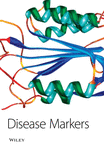CD99 and HLA-II Immunostaining in Breast Cancer Tissue and Their Correlation with Lymph Node Metastasis
Abstract
In an attempt to better unfold the antitumor immune response and invasion strategies perused by tumor cells, markers such as CD99 and HLA-II have been stained in breast tumors, some of them turned out to be important for prognosis and its outcome. CD99 is involved in the intracellular transport of HLA-II proteins. The expression of HLA-II and CD99 molecules has been demonstrated in a broader range of neoplastic tissues, including some epithelial tumors. In the present work, we stained CD99 and HLA-II in breast malignant and non-malignant tissues sections obtained from biopsies resected surgically from 80 Tunisian women. Data implied that CD99 marks malignant tissue significantly as compared to non-malignant breast tissue. HLA-II staining allowed determining the correlation between breast cancer and HLA-II with cytoplasmic localization. CD99 and HLA-II immunostaining was also examined in correlation with two of the most important breast cancer prognostication in routine clinical practice, the lymph node stage and the histological assessment. Results let suggest that CD99+HLA-II– is a marker of worst prognostic since this phenotype is strongly linked to lymph node metastasis in breast cancer.




